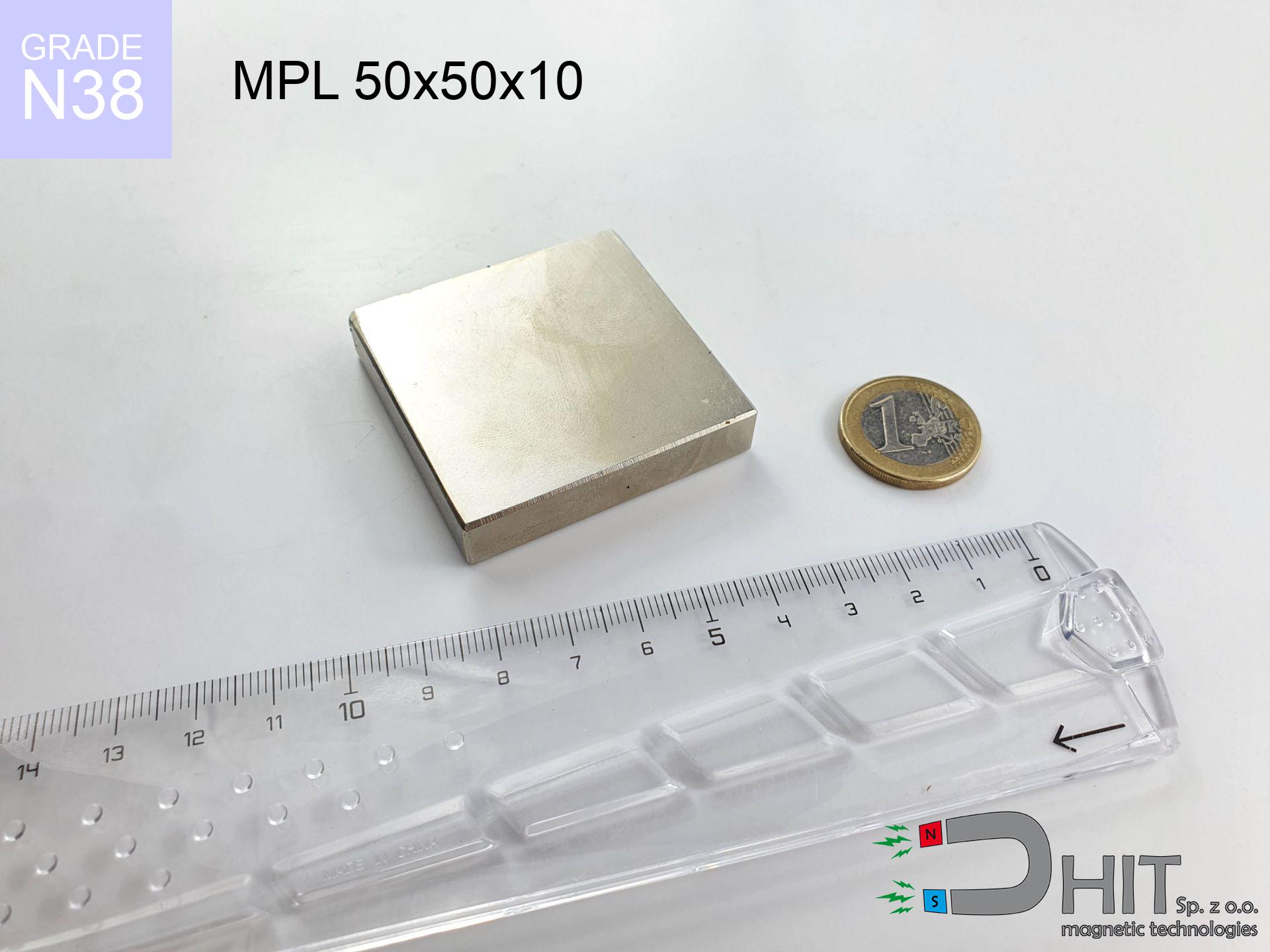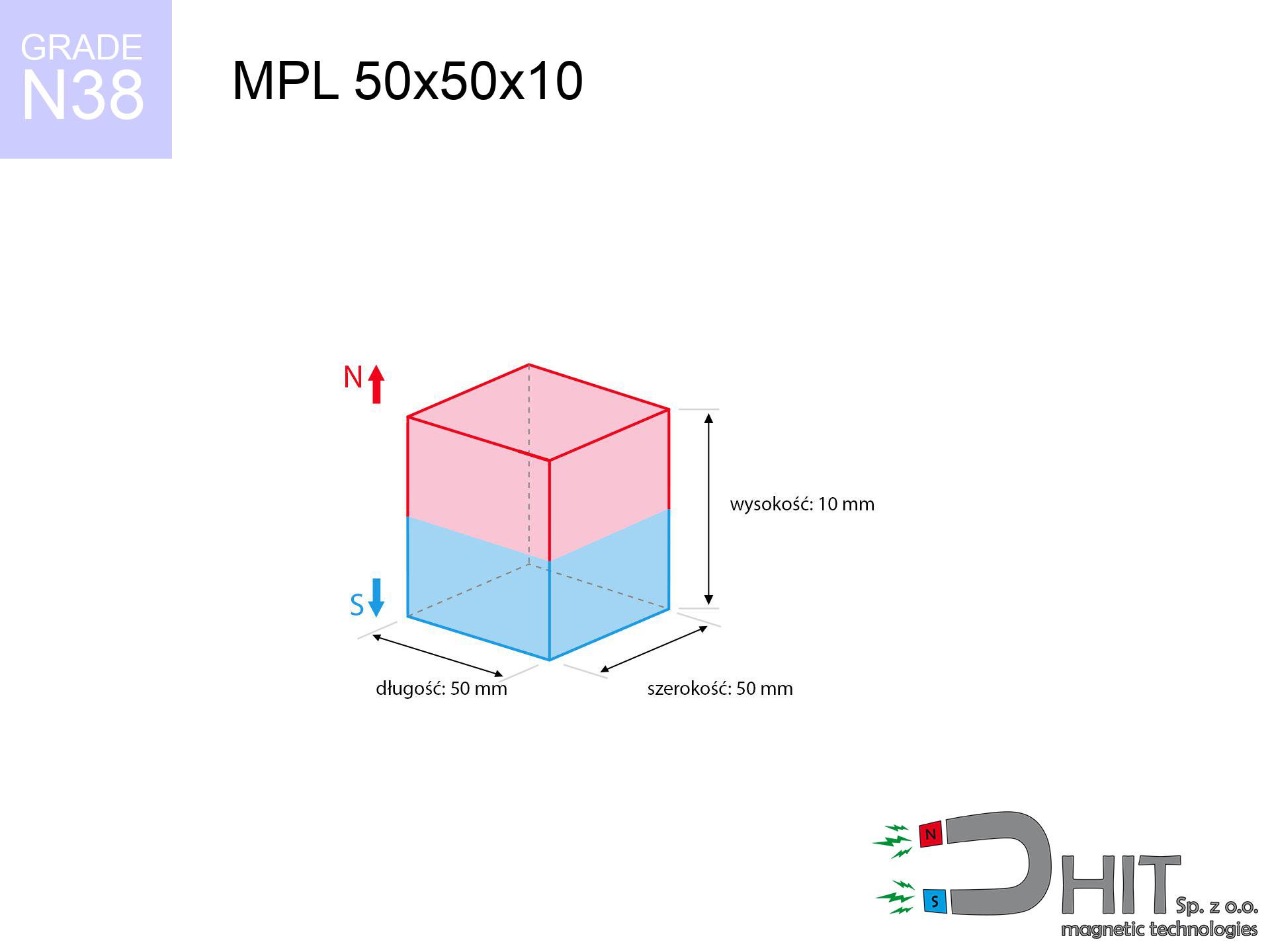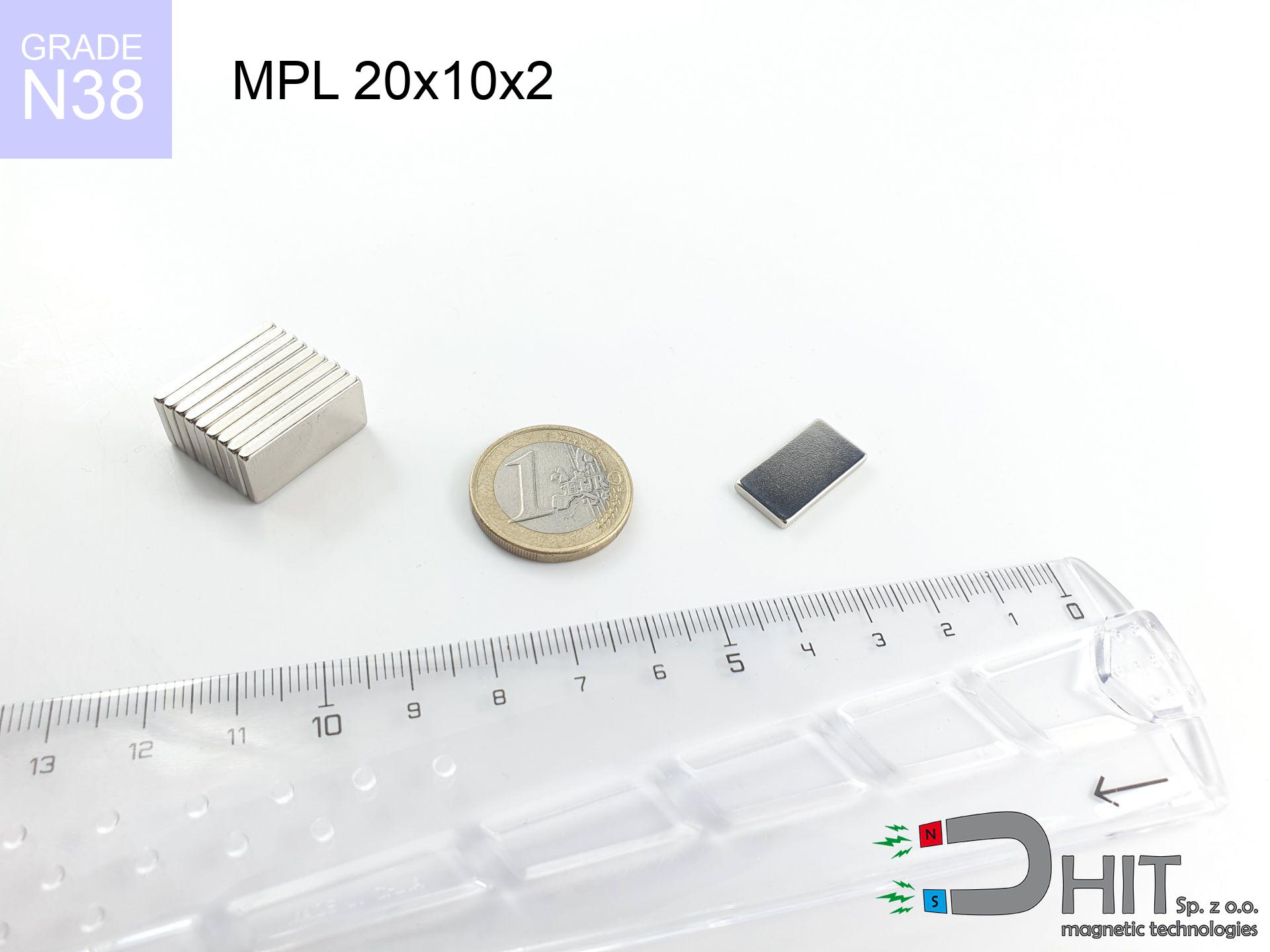MPL 50x50x10 / N38 - lamellar magnet
lamellar magnet
Catalog no 020167
GTIN: 5906301811732
length
50 mm [±0,1 mm]
Width
50 mm [±0,1 mm]
Height
10 mm [±0,1 mm]
Weight
187.5 g
Magnetization Direction
↑ axial
Load capacity
39.48 kg / 387.17 N
Magnetic Induction
209.75 mT
Coating
[NiCuNi] nickel
42.88 ZŁ with VAT / pcs + price for transport
34.86 ZŁ net + 23% VAT / pcs
bulk discounts:
Need more?Not sure about your choice?
Give us a call
+48 888 99 98 98
if you prefer send us a note through
our online form
the contact page.
Force and form of magnetic components can be verified with our
modular calculator.
Same-day processing for orders placed before 14:00.
Magnetic properties of material N38
Physical properties of sintered neodymium magnets Nd2Fe14B at 20°C
Shopping tips
Advantages as well as disadvantages of neodymium magnets.
Besides their tremendous strength, neodymium magnets offer the following advantages:
- They virtually do not lose strength, because even after ten years the performance loss is only ~1% (in laboratory conditions),
- Magnets effectively protect themselves against demagnetization caused by foreign field sources,
- A magnet with a smooth gold surface has an effective appearance,
- The surface of neodymium magnets generates a strong magnetic field – this is a distinguishing feature,
- Through (appropriate) combination of ingredients, they can achieve high thermal resistance, enabling operation at temperatures reaching 230°C and above...
- Thanks to versatility in constructing and the capacity to adapt to specific needs,
- Key role in advanced technology sectors – they are utilized in mass storage devices, brushless drives, precision medical tools, also industrial machines.
- Relatively small size with high pulling force – neodymium magnets offer strong magnetic field in small dimensions, which enables their usage in compact constructions
Problematic aspects of neodymium magnets and ways of using them
- Brittleness is one of their disadvantages. Upon intense impact they can break. We recommend keeping them in a special holder, which not only secures them against impacts but also increases their durability
- When exposed to high temperature, neodymium magnets experience a drop in strength. Often, when the temperature exceeds 80°C, their power decreases (depending on the size and shape of the magnet). For those who need magnets for extreme conditions, we offer [AH] versions withstanding up to 230°C
- They rust in a humid environment. For use outdoors we recommend using waterproof magnets e.g. in rubber, plastic
- We recommend a housing - magnetic mount, due to difficulties in producing nuts inside the magnet and complex forms.
- Health risk related to microscopic parts of magnets can be dangerous, if swallowed, which is particularly important in the context of child health protection. It is also worth noting that small components of these devices are able to complicate diagnosis medical when they are in the body.
- High unit price – neodymium magnets cost more than other types of magnets (e.g. ferrite), which can limit application in large quantities
Best holding force of the magnet in ideal parameters – what it depends on?
Magnet power is the result of a measurement for ideal contact conditions, taking into account:
- on a plate made of mild steel, effectively closing the magnetic field
- possessing a thickness of min. 10 mm to ensure full flux closure
- with a plane free of scratches
- without any insulating layer between the magnet and steel
- under perpendicular force direction (90-degree angle)
- in temp. approx. 20°C
Practical aspects of lifting capacity – factors
Please note that the application force will differ subject to the following factors, starting with the most relevant:
- Air gap (between the magnet and the plate), as even a tiny distance (e.g. 0.5 mm) leads to a drastic drop in lifting capacity by up to 50% (this also applies to varnish, corrosion or dirt).
- Load vector – highest force is reached only during perpendicular pulling. The force required to slide of the magnet along the surface is usually many times lower (approx. 1/5 of the lifting capacity).
- Wall thickness – the thinner the sheet, the weaker the hold. Magnetic flux passes through the material instead of converting into lifting capacity.
- Metal type – different alloys attracts identically. Alloy additives worsen the interaction with the magnet.
- Surface quality – the more even the plate, the larger the contact zone and stronger the hold. Roughness acts like micro-gaps.
- Thermal factor – high temperature weakens pulling force. Too high temperature can permanently damage the magnet.
* Lifting capacity testing was performed on a smooth plate of optimal thickness, under perpendicular forces, in contrast under parallel forces the lifting capacity is smaller. In addition, even a small distance {between} the magnet’s surface and the plate reduces the holding force.
H&S for magnets
Mechanical processing
Combustion risk: Neodymium dust is highly flammable. Avoid machining magnets without safety gear as this risks ignition.
Adults only
NdFeB magnets are not suitable for play. Eating multiple magnets can lead to them pinching intestinal walls, which poses a critical condition and requires immediate surgery.
Do not underestimate power
Before use, check safety instructions. Uncontrolled attraction can break the magnet or injure your hand. Think ahead.
ICD Warning
Warning for patients: Powerful magnets disrupt medical devices. Keep at least 30 cm distance or request help to handle the magnets.
Magnetic media
Intense magnetic fields can destroy records on credit cards, HDDs, and other magnetic media. Keep a distance of min. 10 cm.
Magnets are brittle
Despite the nickel coating, neodymium is delicate and cannot withstand shocks. Do not hit, as the magnet may shatter into sharp, dangerous pieces.
Heat warning
Keep cool. Neodymium magnets are sensitive to heat. If you require resistance above 80°C, ask us about special high-temperature series (H, SH, UH).
Precision electronics
An intense magnetic field interferes with the functioning of magnetometers in smartphones and GPS navigation. Maintain magnets close to a device to avoid breaking the sensors.
Serious injuries
Protect your hands. Two powerful magnets will snap together immediately with a force of several hundred kilograms, destroying everything in their path. Exercise extreme caution!
Allergic reactions
Nickel alert: The Ni-Cu-Ni coating contains nickel. If skin irritation appears, cease working with magnets and use protective gear.
Warning!
Learn more about hazards in the article: Magnet Safety Guide.





![UMP 75x25 [M10x3] GW F200 GOLD / N42 - search holder UMP 75x25 [M10x3] GW F200 GOLD / N42 - search holder](https://cdn3.dhit.pl/graphics/products/ump-75x25-m10x3-gw-f200-gold-pag.jpg)



